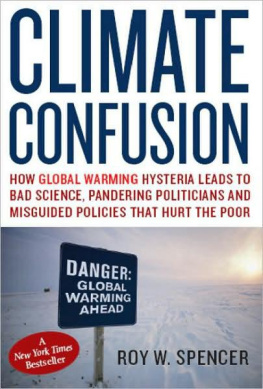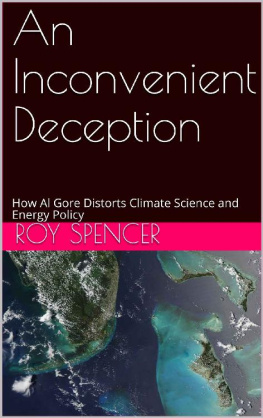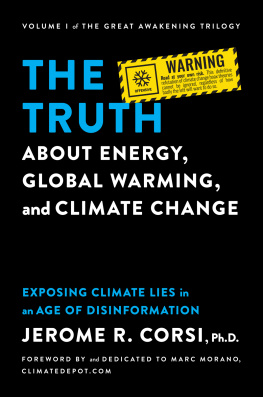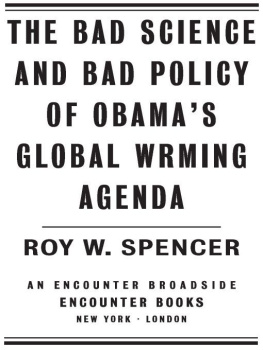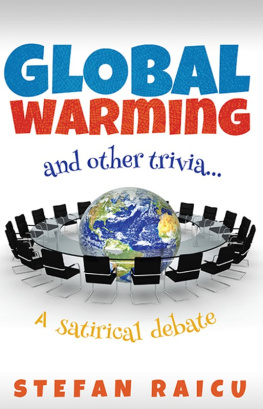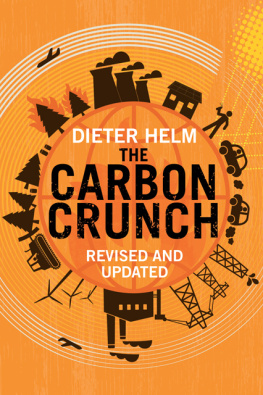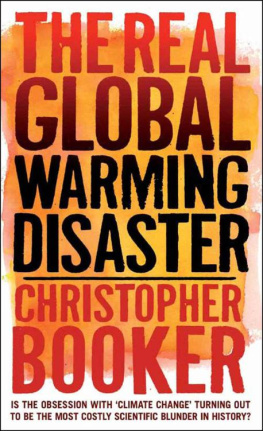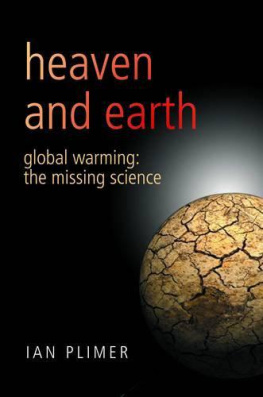Table of Contents
PRAISE FOR
The Great Global Warming Blunder
Striking. The Washington Times
Roy Spencers factual treatment of the global warming debate is essential reading for serious people of good will who are concerned about this matter. What you dont know in this debate can hurt you, and Dr. Spencer does an excellent job of bringing the crucial knowledge to the public. He lays out evidence that demands a verdict.
JOE BASTARDI
chief hurricane and
long-range meteorologist,
AccuWeather.com
With clarity and wit, Dr. Spencer explains the key aspects of global warming physics and makes a strong case that the satellite data of the past ten years are at odds with a central tenet of alarmist dogmathat the warming effects of carbon dioxide will be greatly amplified by clouds and water vapor. Moreover, he points out that higher levels of CO2 are probably good for mankind, since plant life depends on CO2 and preindustrial CO2 levels are substantially lower than most plants would prefer. Dr. Spencer shows courage in speaking these and many other inconvenient truths.
WILL HAPPER
Professor of Physics,
Princeton University
Spencer devotes several chapters to the important role of feedback in understanding climate and the need to carefully separate it from existing forcing (causes) to avoid overestimating the sensitivity of climate to external changes.
CLAUDE SANDROFF, Canada Free Press
Spencer published this evidence in the peer-reviewed Journal of Climate in 2008, but it was ignored by the IPCC and by the mainstream presshence the book. He is taking his case to the public. The book is written in laymans terms with easy-to-understand examples of how the climate works. He also takes on the establishment and shows how there is a vested interest in maintaining the fiction that there is a climate change problem.
JONATHAN DUHAMEL, TucsonCitizen.com
Although Spencer is a scientist, he does a great job of presenting examples that draw on everyday activities that people engage in, to help explain how clouds and weather patterns affect the Earths warming and cooling trends.
JOANNA SCHROEDER, DomesticFuel.com
Preface to the Paperback Edition
SINCE THE original publication of The Great Global Warming Blunder in 2010, I have received many favorable comments, from experts and non-experts alike. But there have also been several concerted attempts to discredit the central thesis of the book: that natural cloud variations cause temperature variations, which give the illusion that the climate system is very sensitive to humanitys greenhouse gas emissions.
The fight to undermine this message has taken the form of public ridicule by scientists in press reports, and political pressure on scientific journal editors to not publish our research on this subject. What is interesting about these antagonistic efforts is that they are usually made by scientists who do not publish in the same field of research, have not even read the paper in question, or are just repeating criticisms they have heard from a small minority of activist scientists. Usually the criticisms are red herrings, straw men, ad hominem attacks, or simply made up out of thin air.
This is the nature of global warming research today. The issue is so divisiveeven among scientists - that objectivity has been tossed out the window under the guise of Saving the Earth. Some scientists have taken to calling researchers like me and my colleagues climate change deniers, even though (natural) climate change was being studied long before anthropogenic global warming became a popular topic.
Our most recent paper supporting the theme of this book was peer-reviewed and accepted by top experts in our field, and published in the journal Remote Sensing in 2011. Astonishingly, as a result of that paper being published, the chief editor of Remote Sensing was forced to resign after apparent pressure by an influential gatekeeper for the UNs Intergovernmental Panel on Climate Change (IPCC)even though our paper was never retracted by the journal. The only scientific paper published in response to ours also appeared in 2011, in Geophysical Research Letters , and it contained what I would consider to be sloppy and unprofessional science. We submitted a rebuttal, which included new evidence to further support our case, and which we made as bulletproof as possible. It was rejected outright in late 2011, given the next-to-worst numerical score by all four reviewers.
Such a suspiciously uniform negative response seems more like collusion than coincidence. Even our most controversial papers in the past had received favorable reviews from at least half the reviewers. If you doubt my thinly veiled accusation of collusion, just examine the Climategate I and Climategate II email releases widely available and discussed on the internet. The IPCC core scientists obviously have years of experience intimidating editors of scientific journals and skewing the peer review process. The IPCC has been working for over twenty years to build a scientific case to support carbon dioxide regulation, and our research is clearly a threat to their efforts.
Despite the attacks, I continue to stand behind our research 100 percent, as well as the opinions put forth in this book.
The insistence of the IPCC and the scientific consensus that clouds cannot cause climate variations continues to astound me. All atmospheric scientists know that clouds are controlled by a multitude of factors; my position is that causation between clouds and temperature flows in both directions. In contrast, the IPCCs position is that clouds can only change in response to temperature change (temperature clouds). But neglecting causation in the opposite direction (clouds temperature) can lead to large errors in our understanding of how and why the climate system changes, as well as in our diagnosis of how sensitive the climate system is to human influences.
In science, nothing is ever proved. Science provides a way to investigate alternative explanations (hypotheses) for how the world works. Unfortunately, in global warming research only one hypothesis is now allowed by the adherents to the IPCC process and narrative. Most observed changes in the climate system are now interpreted under the assumption that humans are the cause.
The reason why such a bias exists in climate research is beyond the scope of this book, but I will say it involves political influence, money, worldviews, misunderstandings over economics and risk, and even religious beliefs regarding the role of humans in nature. I discussed all of these issues in my previous book, Climate Confusion .
I fear that the publics confidence in the scientific establishment they support with their tax dollars will eventually be destroyed, and climate science as a research discipline will be destroyed along with it. While scientists have been digging in their heels in spite of mounting evidence they could be wrong, public opinion has shifted in the last several years away from global warming having a predominantly human cause. As a result, the IPCC and its scientist-cheerleaders seem increasingly disconnected from the opinions of the citizens who financially support them, and there is no end in sight to this division.
March 2011
Introduction & Background
CARBON FOOTPRINTS, carbon offsets, carbon taxes, carbon credits, carbon dioxide laws and regulations, cap-and-trade, going green, green energythese terms are now part of our modern lexicon. We are told that Earths average temperature is higher today than it has been for hundreds or even thousands of years; that humanity, not nature, now controls the climate system; that the evidence of a manmade climate crisis is everywhere; that we must drastically reduce our greenhouse gas emissions in order to save the planet. This is the new orthodoxy.


